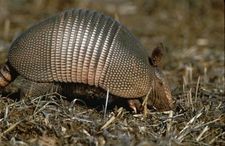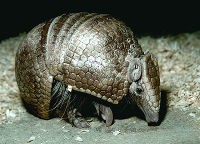Armadillo Sunrise
Posted by: Loren Coleman on August 13th, 2006

The nine-banded armadillo (above) is making inroads into the northern USA. Dasypus novemcinctus is most common in the central southern states, such as Texas, and abdundant in some parts of Florida.
If you run into armadillos in Missouri or southern Illinois, they are not cryptids or out-of-place animals. They are animals that are extending their range northward. As has been noted here briefly before (regarding birds and alligators), cryptozoologists need to keep track of this topic, so as to make certain we don’t confuse these natural range changes for “new animals” or folks’ sightings of bizarre and seemingly new animals as some kind of evidence of a cryptid.
Reporter Ken Leiser discusses the new northern march of this species in his article, “Armadillos have migrated north, and they’re ‘here to stay,'” in the St. Louis Post-Dispatch of August 13, 2006. Here’s the essence of what he says that impacts on our cryptozoological pursuits:
Armadillos began pushing into southern Missouri in the early 1980s, but sightings have been rare in St. Louis and surrounding counties until recently. The small armored animals had long been associated with warmer, Southern states but have shown they can adapt to winter temperatures in central Missouri and Southern Illinois.
“They are here to stay,” said Professor Lynn Robbins of Missouri State University.
Earlier this year, a Ladue woman was surprised to spot one of the nine-banded armadillos digging up part of her yard, said Tom Meister, a wildlife damage biologist for the Missouri Department of Conservation in the St. Louis area.
* * *
“They are becoming more and more common,” Meister said, particularly in Crawford and Washington counties, on the fringes of the St. Louis area.
* * *
There have been a growing number of armadillo sightings in Southern Illinois, especially in the last five years, said Clay Nielsen, a research scientist at Southern Illinois University Carbondale.
Since reaching Texas in the mid-1800s, the armadillo has pushed into the Southeast and now the lower Midwest. Despite the animal’s preference for warmer temperatures, Nielsen said “it is too early to say” whether global warming is contributing to the expansion.
“It has been a slow, gradual spread over a 150-year period,” Nielsen said.
Robbins’ research shows that the northern march has averaged several miles a year.
* * *
Robbins figured heavy snows several years ago would have knocked the population back, but the armadillos were present after the snow melted.
So far, Robbins said, they have weathered Missouri winters by sticking to places where ice and snow aren’t so heavy – like the edge of streams and beneath large trees. They rustle beneath leaf litter to find bugs, even in cold weather.
The critters are deceptively fast and can jump three to four feet into the air when startled. The most reliable evidence of their arrival is the occasional sight of an armadillo that has been hit by a car.
* * *
Two years ago, Missouri Department of Transportation maintenance workers in Franklin County weren’t seeing armadillos among the road kill they clear from highways. Now they see about one a week, said spokeswoman Linda Wilson.
By contrast, maintenance workers in the Department of Transportation’s 12-county region near Springfield, Mo., see them “every day,” said spokesman Bob Edwards. The sightings seem to increase each year.
* * *
I know one thing for sure. I would have enjoyed having some armadillos around when I took that 5 a.m. ornithology class at Southern Illinois University Carbondale in the late 1960s. Armadillos jumping 4 feet into the air might have kept me awake as we hiked around the woods looking for woodpeckers and songbirds and learning their Latin names. Unfortunately, today I live in apparently the only state, Maine, where it is illegal to own an armadillo, so there’s no keeping one as a pet here. Maine sightings of armadillos are zero.


Residents of South America, the Southern Three-banded Armadillo (Tolypeutes matacus) and the Brazilian Three-banded Armadillo (Tolypeutes tricinctus) are not the ones showing up in Missouri and Illinois, yet. If we start getting any reports of the Three-banded armadillo in Missouri and Illinois, spaceship Earth may be overheating a bit too much.
About Loren Coleman
Loren Coleman is one of the world’s leading cryptozoologists, some say “the” leading living cryptozoologist. Certainly, he is acknowledged as the current living American researcher and writer who has most popularized cryptozoology in the late 20th and early 21st centuries.
Starting his fieldwork and investigations in 1960, after traveling and trekking extensively in pursuit of cryptozoological mysteries, Coleman began writing to share his experiences in 1969. An honorary member of Ivan T. Sanderson’s Society for the Investigation of the Unexplained in the 1970s, Coleman has been bestowed with similar honorary memberships of the North Idaho College Cryptozoology Club in 1983, and in subsequent years, that of the British Columbia Scientific Cryptozoology Club, CryptoSafari International, and other international organizations. He was also a Life Member and Benefactor of the International Society of Cryptozoology (now-defunct).
Loren Coleman’s daily blog, as a member of the Cryptomundo Team, served as an ongoing avenue of communication for the ever-growing body of cryptozoo news from 2005 through 2013. He returned as an infrequent contributor beginning Halloween week of 2015.
Coleman is the founder in 2003, and current director of the International Cryptozoology Museum in Portland, Maine.










Coyotes have also been expanding their range. If I remember correctly, their range is even greater now than it was before the colonial period. I believe this is attributed to their ability to live in close proximity to man. The apex predators like bears, wolves, and mountain lions have been reduced, so the coyote has moved into their niches. I think I also heard something about some of them starting to grow bigger, also attributed to them moving into the niches vacated by the apex predators.
And this is cryptozoologically significant, as this accounts for some unknown canid or “wolf” sightings. And of course you have the “mangy coyote as chupacabras” flaps.
We have them moving north through Kansas also. My wife and I saw road kill armadillo right outside Topeka not long ago. (Along with a LARGE Black Cat not much further down the road—but that’s another issue).
Well just another animal trying to survive by finding somewhere else to live. I do not know much about them are they agressive or docile. Are they a threat to any of the local wildlife in Illinois?
They aren’t aggressive! They have big claws, but that’s for digging up worms and insects. I’m not sure what local animals they might compete with, since in the South they live alongside creatures like opposums, raccoons, skunks, and the like.
Part of the reason they spook so easily is that they have poor eye-sight, and when you get too close without them hearing you they will jump like in the article. I love these little guys myself, although they will tear the heart right out of your flowerbeds and gardens. I wonder if they’ve made it to NC yet?
I’ve seen them get pretty large (if they don’t meet their maker on a highway), so if reports of armored dogs start coming in, I’ll know what they are! The oldtimer that I saw once had a broken tail that was forked…I don’t know if they can regenerate a broken tail, but it was really strange. It was at the tip, and kind of looked like what happens when the little green anoles don’t lose their tail completely when they break off. I would’ve given it 20 lbs. easily, and it looked like a little tank bulldozing it’s way through the woods. I imagine anyone coming across something like this animal not knowing what it was would be a little freaked out.
Coyotes have recently been causing a stink in Cape May, NJ, owing to their habit of making off with defenseless poodles about once every few weeks or so.
“Coyotes have also been expanding their range. If I remember correctly, their range is even greater now than it was before the colonial period. I believe this is attributed to their ability to live in close proximity to man. The apex predators like bears, wolves, and mountain lions have been reduced, so the coyote has moved into their niches. I think I also heard something about some of them starting to grow bigger, also attributed to them moving into the niches vacated by the apex predators.
And this is cryptozoologically significant, as this accounts for some unknown canid or “wolf” sightings. And of course you have the “mangy coyote as chupacabras” flaps. ”
Funny thing about that is that wolves were basically eliminated in the continental US because people (wrongly) feared them to be dangerous… even though wild wolves rarely if ever attack people. The flipside is that now Coyotes are taking their place. And coyotes will attack people. That’s what you get for fooling with mother nature.
shovethenos where do you live? In California mountain lions are protected better than humans, in fact if you were to shoot one, without proper rancher/shepherd permit to protect your herd, literally the mountain lion will have to attack and at least scratch you so when fish and game come to check things out you could say it was self-defense. as far as the note about coyotes, you all realize that in some areas the coyote mated with the last of the wolves, so that now we have larger coyotes that are willing to do whatever it takes to eat. I love armadillos. I lived in texas (dallas area) for 3 years. Not a day went by that I didn’t see one on the road. They can get to good sizes.
If Armadillos are not Crypto-significant because they are merely expanding their boundaries, why are big-cats Crypto-significant? Aren’t they doing the same thing?
Shumway,
I believe shovethenos is talking historically, not in a contemporary sense. Yes today they are protected after having been nearly wiped out.
Also I hear a lot about coyotes mating with wolves. Where is the evidence for this?
I have read a lot about “coydogs”, but these are often rendered effectively sterile, not because of a lack of viable sperm/ovum, but because of difference in the estrus cycles of the two canines.
Can anyone point me to this coywolf evidence?
Maer- You make a point, but the main difference here is that the range of Big Cats is actually decreasing, and yet people are seeing them in places they couldn’t possibly have expanded into naturally, like Britain or Cleveland. Now, an Armadillo in London, that’d be news.